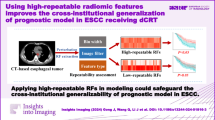Abstract
We attempted to investigate the Radiomic feature (RF) repeatability and its agreements across imaging modalities and head-and-neck cancer (HNC) subtypes via image perturbations. Contrast-enhanced computed tomography (CECT), CET1-weight, T2-weight magnetic resonance images of 231 nasopharyngeal carcinoma (NPC) patients, and CECT images of 399 oropharyngeal carcinoma (OPC) patients were retrospectively analyzed. Randomized translation and rotation were implemented to the images for mimicking scanning position stochasticity. 1288 RFs from unfiltered, Laplacian-of-Gaussian-filtered (LoG), and wavelet-filtered images were subsequently computed per perturbed image. The intra-class correlation coefficient (ICC) was calculated to assess RF repeatability. The mean absolute difference (MAD) of the ICC and the binarized repeatability consistency between image sets were adopted to evaluate its agreements across imaging modalities and HNC subtypes. Bias from feature collinearity was also investigated. All the shape RFs and the majority of RFs from unfiltered (\(\ge \)83.5%) and LoG-filtered (\(\ge \)93%) images showed high repeatability (ICC \(\ge \) 0.9) in all studied datasets, whereas more than 50% of the wavelet-filtered RFs had low repeatability (ICC < 0.9). RF repeatability agreements between imaging modalities within the NPC cohort were outstanding (MAD < 0.05, consistency > 0.9) and slightly higher between the NPC and OPC cohort (MAD = 0.06, consistency = 0.89). Minimum bias from feature collinearity was observed. We urge caution when handling wavelet-filtered RFs and advise taking initiatives to exclude underperforming RFs during feature pre-selection for robust model construction.
Access this chapter
Tax calculation will be finalised at checkout
Purchases are for personal use only
Similar content being viewed by others
References
Beare, R., Lowekamp, B., Yaniv, Z.: Image segmentation, registration and characterization in R with SimpleiTK. J. Stat. Softw. 86(1), 1–35 (2018). https://doi.org/10.18637/jss.v086.i08
Bianchini, L., et al.: A multicenter study on radiomic features from T2-weighted images of a customized MR pelvic phantom setting the basis for robust radiomic models in clinics. Magn. Reson. Med. 00, 1–14 (2020). https://doi.org/10.1002/mrm.28521
Dehing-Oberije, C., et al.: Tumor volume combined with number of positive lymph node stations is a more important prognostic factor than TNM stage for survival of non-small-cell lung cancer patients treated with (chemo)radiotherapy. Int. J. Radiat. Oncol. Biol. Phys. 70(4), 1039–1044 (2008). https://doi.org/10.1016/j.ijrobp.2007.07.2323
Elshafeey, N., et al.: Multicenter study demonstrates radiomic features derived from magnetic resonance perfusion images identify pseudoprogression in glioblastoma. Nat. Commun. 10(1), 3170 (2019). https://doi.org/10.1038/s41467-019-11007-0
Fiset, S., et al.: Repeatability and reproducibility of MRI-based radiomic features in cervical cancer. Radiother. Oncol. 135, 107–114 (2019). https://doi.org/10.1016/j.radonc.2019.03.001
Gourtsoyianni, S., et al.: Primary rectal cancer: repeatability of global and local-regional MR imaging texture features. Radiology 284(2), 552–561 (2017). https://doi.org/10.1148/radiol.2017161375
Griethuysen, V.J.J.M., et al.: Computational radiomics system to decode the radiographic phenotype. Cancer Res. 77(21), e104–e107 (2017). https://doi.org/10.1158/0008-5472.CAN-17-0339
Lambin, P., et al.: Radiomics: the bridge between medical imaging and personalized medicine. Nat. Rev. Clin. Oncol. 14(12), 749–762 (2017). https://doi.org/10.1038/nrclinonc.2017.141
Liu, R., et al.: Stability analysis of CT radiomic features with respect to segmentation variation in oropharyngeal cancer. Clin. Transl. Radiat. Oncol. 21, 11–18 (2020). https://doi.org/10.1016/j.ctro.2019.11.005
Lu, H., et al.: Repeatability of quantitative imaging features in prostate magnetic resonance imaging. Front. Oncol. 10, 551 (2020). https://doi.org/10.3389/fonc.2020.00551
McGraw, K.O., Wong, S.P.: Forming inferences about some intraclass correlation coefficients. Psychol. Methods 1(1), 30–46 (1996). https://doi.org/10.1037/1082-989X.1.1.30
Nie, K., et al.: NCTN assessment on current applications of radiomics in oncology. Int. J. Radiat. Oncol. Biol. Phys. 104(2), 302–315 (2019). https://doi.org/10.1016/j.ijrobp.2019.01.087
Park, J.E., Park, S.Y., Kim, H.J., Kim, H.S.: Reproducibility and generalizability in radiomics modeling: possible strategies in radiologic and statistical perspectives. Korean J. Radiol. 20(7), 1124–1137 (2019). https://doi.org/10.3348/kjr.2018.0070
Schwier, M., et al.: Repeatability of multiparametric prostate MRI radiomics features. Sci. Rep. 9(1), 9441 (2019). https://doi.org/10.1038/s41598-019-45766-z
Sheikh, K., et al.: Predicting acute radiation induced xerostomia in head and neck cancer using MR and CT radiomics of parotid and submandibular glands. Radiat. Oncol. 14(1), 131 (2019). https://doi.org/10.1186/s13014-019-1339-4
Traverso, A., Wee, L., Dekker, A., Gillies, R.: Repeatability and reproducibility of radiomic features: a systematic review. Int. J. Radiat. Oncol. Biol. Phys. 102(4), 1143–1158 (2018). https://doi.org/10.1016/j.ijrobp.2018.05.053
van Velden, F.H.P., et al.: Repeatability of radiomic features in non-small-cell lung cancer [18F]FDG-PET/CT studies: impact of reconstruction and delineation. Mol. Imag. Biol. 18(5), 788–795 (2016). https://doi.org/10.1007/s11307-016-0940-2
Wang, G., He, L., Yuan, C., Huang, Y., Liu, Z., Liang, C.: Pretreatment MR imaging radiomics signatures for response prediction to induction chemotherapy in patients with nasopharyngeal carcinoma. Eur. J. Radiol. 98, 100–106 (2018). https://doi.org/10.1016/j.ejrad.2017.11.007
Zhang, L., et al.: Radiomic nomogram: pretreatment evaluation of local recurrence in nasopharyngeal carcinoma based on MR imaging. J. Cancer 10(18), 4217–4225 (2019). https://doi.org/10.7150/jca.33345
Zhang, L.L., et al.: Pretreatment MRI radiomics analysis allows for reliable prediction of local recurrence in non-metastatic T4 nasopharyngeal carcinoma. EBioMedicine 42, 270–280 (2019). https://doi.org/10.1016/j.ebiom.2019.03.050
Zwanenburg, A., et al.: Assessing robustness of radiomic features by image perturbation. Sci. Rep. 9(1), 614 (2019). https://doi.org/10.1038/s41598-018-36938-4
Author information
Authors and Affiliations
Corresponding author
Editor information
Editors and Affiliations
A 6 Appendix
A 6 Appendix
Category-based binary radiomics feature repeatability separated by volume groups for (a) CECT, CET1-w MR, and T2-w MR of the NPC cohort and (b) CECT of the NPC cohort and CECT of the OPC cohort. The top figure is the histogram of the ROI volume for the NPC patient cohort, and the dashed black lines indicate the four threshold values for patient grouping.
Rights and permissions
Copyright information
© 2022 The Author(s), under exclusive license to Springer Nature Switzerland AG
About this paper
Cite this paper
Zhang, J. et al. (2022). Repeatability of Radiomic Features Against Simulated Scanning Position Stochasticity Across Imaging Modalities and Cancer Subtypes: A Retrospective Multi-institutional Study on Head-and-Neck Cases. In: Qin, W., Zaki, N., Zhang, F., Wu, J., Yang, F. (eds) Computational Mathematics Modeling in Cancer Analysis. CMMCA 2022. Lecture Notes in Computer Science, vol 13574. Springer, Cham. https://doi.org/10.1007/978-3-031-17266-3_3
Download citation
DOI: https://doi.org/10.1007/978-3-031-17266-3_3
Published:
Publisher Name: Springer, Cham
Print ISBN: 978-3-031-17265-6
Online ISBN: 978-3-031-17266-3
eBook Packages: Computer ScienceComputer Science (R0)






